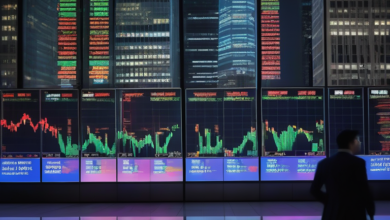Stock Market 9 August 2024: Is This Already the Turnaround?

Key Highlights
- U.S. stocks closed higher on Friday, marking a significant recovery from Monday’s steep sell-off.
- The S&P 500 saw its best day since November 2022 on Thursday, fueled by easing recession fears.
- The Nasdaq Composite, heavily weighted with tech stocks, also posted substantial gains.
- Tesla’s unexpected profit surge and Amazon’s expansion announcement boosted investor sentiment.
- Market analysts attributed the volatility to hedge fund activity and seasonal factors rather than fundamental economic concerns.
S&P 500 Sees Notable Recovery
The S&P 500 is an important benchmark index for the U.S. stock market. This week, it made a strong recovery, bouncing back from most of its losses after a big sell-off on Monday. On Monday, the index dropped by 3%, which was its worst day since 2022. However, it climbed all week and closed on Friday up by 0.47%. This recovery came from good economic data and less worry about the Federal Reserve’s interest rate plans.
On Thursday, the S&P 500 rose by 2.3%. This was its best day since November 2022. This gain was due to positive news about weekly jobless claims, which helped calm fears of a recession. Even though it was a shaky week, the S&P 500 ended only slightly lower. This shows that the market is strong and hints at a possible turnaround.
Dow Jones Industrial Average Ends Higher
The Dow Jones Industrial Average, which tracks 30 big U.S. companies, ended the week positively after a tricky start. On Monday, there was a big drop of 1,000 points, but by Friday, the Dow was up 0.13%. This rebound happened due to a mix of things, like good economic data and a change in how investors felt.
A report from the Labor Department on Thursday showed fewer jobless claims than expected. This helped calm worries in the market. It showed that the labor market is still strong, lowering fears of a recession. Even though the Dow was down 0.6% for the week, the late recovery shows that investors are still hopeful despite the volatility.
Nasdaq Composite Index: Tech Stocks Rally
The Nasdaq Composite, which has many tech companies, showed a recovery in the market by going up 0.51% by the end of Friday. Earlier in the week, the index had fallen into correction territory. This was due to worries about rising interest rates and how they might affect growth in the tech sector. However, strong Q1 results from some tech giants boosted the market again, showing that the sector is still strong.
Also, good news from companies like Nvidia and Tesla raised investor confidence. Nvidia reported strong revenue in July, showing high demand for its chips. This news, along with Tesla’s surprise profit jump, pushed the Nasdaq up, hinting at a possible return to strong growth.
Tesla’s Unexpected Profit Surge
Tesla, the electric vehicle maker led by CEO Elon Musk, boosted the stock market this week with surprising profit growth. Even with worries about how economic issues could affect spending, Tesla shared strong quarterly earnings that went beyond what analysts expected. This good news made Tesla’s stock price rise, helping the market overall.
The company’s ability to stay profitable during hard times shows its strong position in the market and its innovative approach. Tesla’s results remind us that even with economic challenges, companies with solid business plans and a clear vision can succeed. This brings hope for growth in the market.
Amazon Announces Expansion, Stock Jumps
Amazon, the big online store, made news this week. They shared plans to grow their business, which made their stock price go up. Even with tough economic times, Amazon’s decision shows they believe in their future growth. Traders jumped on the news and bought shares, which helped boost the overall market.
This action shows that Amazon is focused on innovation and staying a leader in their field. By reaching out more and investing in new projects, Amazon is getting ready for more growth, despite economic hurdles. This clear move made investors feel good, as they believe strong earnings can help improve the market.
Pfizer’s Latest Drug Approval Shakes Up Healthcare Sector
Pfizer, a big name in the pharmaceutical world, grabbed attention this week. Their new drug got approval, which is shaking up the healthcare sector. This news gave hope during tough economic times. It raised Pfizer’s stock price and made investors more positive about the healthcare industry.
Even with worries about the Federal Reserve’s actions and how they may affect the economy, this approval shows that there is room for new ideas in healthcare. These new ideas can help growth during uncertain times.
The drug approval is a strong reminder that healthcare can lead to important breakthroughs. These breakthroughs can change how patients feel and bring economic benefits. This news offered good hope for investors looking for safety in a rocky market. It shows that the healthcare industry can be strong and bounce back.
Market Analysis: Understanding the Turnaround
The stock market’s fast recovery from Monday’s drop has many people thinking it might be the start of a real change. There are still some questions about how the economy will do, but a few things hint at a new feeling in the market. First, good economic data, especially about the labor market, has lessened worries about a downturn. Also, strong corporate earnings in many industries have boosted investor trust.
Analysts say that some technical factors, like certain hedge funds changing positions, caused the big drop, not because of weak economic conditions. This means the market may have panicked and now has a chance to bounce back quickly. Still, we might see some ups and downs in the short term as investors deal with geopolitical tensions and what the federal reserve decides to do next.
Comparison with Previous Market Corrections
To better understand the recent market volatility, it’s helpful to compare it with previous market corrections. The CBOE Volatility Index (VIX), also known as the “fear gauge,” spiked to levels last seen during the onset of the COVID-19 pandemic and the Great Financial Crisis. This surge in the VIX reflected heightened investor anxiety and uncertainty regarding the economic outlook.
However, unlike previous crises, the current market correction appears to be driven more by technical factors and sentiment shifts than underlying economic weaknesses. The following table summarizes key market indicators during previous corrections:
|
Event |
VIX Peak |
S&P 500 Decline |
Duration (approx.) |
Key Driver |
|
COVID-19 Pandemic |
82.69 |
34% |
1 month |
Pandemic Fears |
|
Great Financial Crisis |
80.86 |
57% |
18 months |
Financial Crisis |
|
Current Correction |
38.57 |
4% (as of Monday) |
1 week |
Technical factors, Sentiment |
While the VIX spiked sharply, it subsided relatively quickly, suggesting that investors are not panicking to the same extent as in previous crises. Additionally, the S&P 500’s decline, though significant, has been far less severe than during past recessions, indicating a possibility that the market is positioned for a relatively swift recovery. Nevertheless, investors should remain cautious as the economic outlook continues to evolve.







